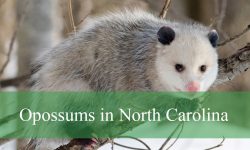Arkansas is home to a diverse array of caterpillar species, each playing a unique role in the state’s ecosystem. These types of caterpillars in Arkansas can be categorized based on their distinctive characteristics and the plants they inhabit. One notable species is the Eastern Tiger Swallowtail caterpillar, easily recognizable by its vibrant green color and false eye spots that serve as a defense mechanism against predators.
Another fascinating caterpillar found in Arkansas is the Io Moth caterpillar, known for its striking appearance with bright green coloration and rows of spines along its back. While their appearance may be captivating, it’s essential to handle them with care as some species can cause skin irritation.
Arkansas is also home to the Pipevine Swallowtail caterpillar, which relies on the Pipevine plant as its primary host. This caterpillar species has a distinct appearance with its black body adorned with orange spots, serving as a warning sign to potential predators.
In the lush forests of Arkansas, the Luna Moth caterpillar can be spotted, characterized by its pale green color and unique appearance. These caterpillars undergo a remarkable transformation, eventually giving rise to the majestic Luna Moth.
These are just a few examples of the diverse types of caterpillars that contribute to the rich biodiversity of Arkansas. Go through the article below to find out more about the 40 different species of caterpillars found in Arkansas.
Different Types of Caterpillars in Arkansas
White-Marked Tussock Caterpillar
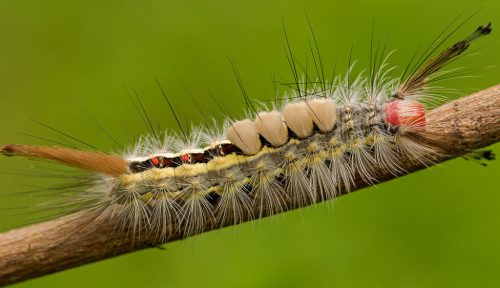
The Black Tufts that mimic antennae and long white hairs accentuate the multicolored body of the White-Marked Tussock Moth Caterpillar (Orgyia leucostigma). It is a remarkable sight, with its enormous red head and red spots around the mid-dorsal area. With yellow stripes for contrast, the rest of its body is primarily black. Although this species is typically observed on rose petals and other flowers in gardens, it also consumes fruit and hardwood trees like oaks and apples. Even after multiple breakouts, these caterpillars eventually die from a contagious sickness.
Tobacco Hornworm Caterpillar
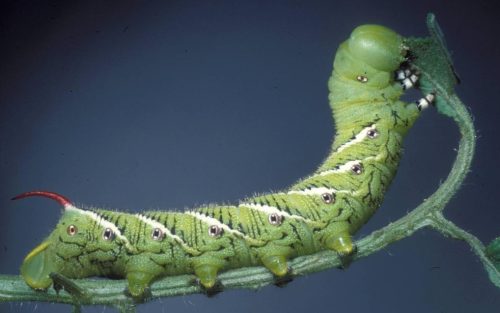
The Manduca Sexta, commonly known as the Tobacco Hornworm, is a vibrant green caterpillar adorned with eyespot markings and white diagonal stripes along its sides. Reaching a length of up to 7cm, it features a distinctive rear horn in brown, green, or orange. Feeding on tobacco, tomato, and eggplant foliage, these creatures share similarities with tomato hornworms, but the tobacco hornworm stands out with its unique diagonal stripes. Host plants include tobacco, tomato, pepper, eggplant, and various ornamental shrubs.
Pipevine Swallowtail Caterpillar
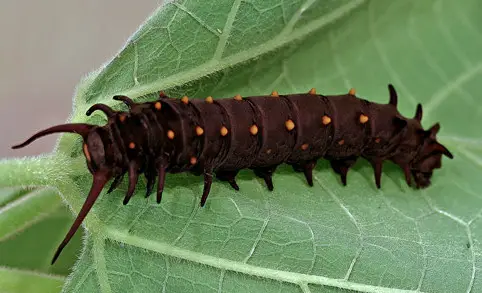
The Battus philenor, or Pipevine swallowtail caterpillar, boasts a dark-brown hue with fleshy horns on its head, tail, and sides. Its distinctive features include two rows of bright orange dots along the back, aiding in easy identification. The caterpillar, adorned with fine hairs for a velvety appearance, can reach a length of 5cm due to its voracious appetite. Host plants for this species include thistle flowers and ironweed plants.
Imperial Moth Caterpillar
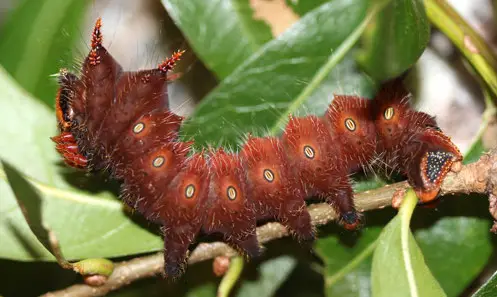
The Imperial Moth Caterpillar, scientifically known as Eacles imperialis, sports long spiky horns on its head and a jagged tail-like protrusion. Ranging in color from orange-brown to dark brown or dark green, it can grow up to 7.5-10cm long. This caterpillar undergoes color changes, with mature ones appearing darker and hairier, signaling pupation. Found on pine, maple, oak, sweetgum, and sassafras foliage, it’s a fascinating species in various growth stages.
Hickory Horned Devil Caterpillar
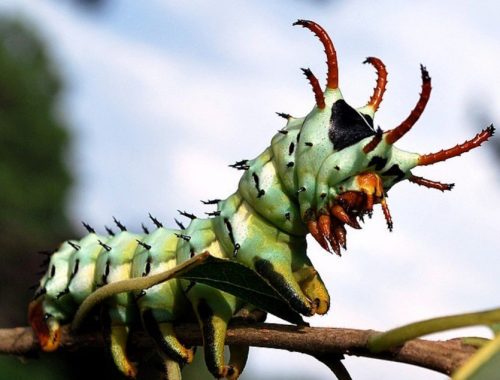
The Hickory-Horned Devil, scientifically known as Citheronia regalis, is a peculiar and harmless caterpillar found in Arkansas. With a bluish-green body adorned with curved spiny horns and black tips, it feeds on walnut, hickory, pecan, and sweetgum leaves. Recognizable by its orangey-red head and menacing red horns, this giant insect transforms into a regal moth after pupation.
Stinging Rose Caterpillar
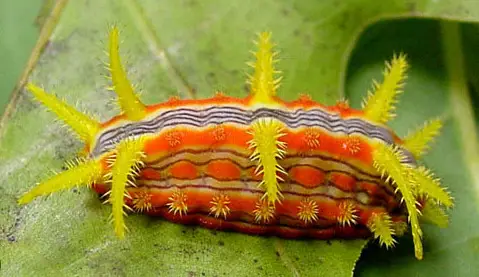
The Stinging Rose Caterpillar, scientifically named Parasa indetermina, is a colorful and venomous species found along the East Coast from New York to Arkansas. With a yellow or orange-red body adorned with thin bands of purple stripes, its distinctive features include jaggy horn-like spikes along the back and clumps of spines along the sides. These caterpillars, growing up to 2.5cm, feed on hickories, oaks, poplars, dogwood, and rose bushes. Caution is advised as handling them can cause skin irritation due to their venomous spines.
Spiny Oak Slug Caterpillar

The Spiny Oak Slug Caterpillar, scientifically named Euclea delphinii, is a vibrant and stinging caterpillar adorned with jagged spikes. Distinctive features include four pairs of upward-pointing spiked orange horns, along with two orange bands featuring circular green and white markings along the back. These spikes contain venom that can cause skin irritation. Found on various deciduous trees and shrubs, they feed on the foliage of apple, ash, birch, basswood, oak, maple, poplar, hackberry, beech, blueberry, and more.
Buck Moth Caterpillar
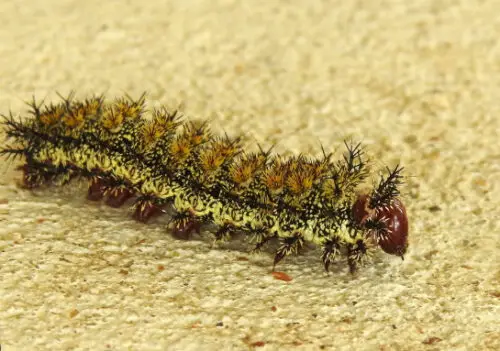
The Buck Moth Caterpillar, scientifically known as Hemileuca maia, is Arkansas’s largest stinging caterpillar. Its black body adorned with tiny white dots and jagged tufts of spines gives it a formidable appearance. Handling these caterpillars is cautioned, as their spines contain venom leading to skin irritation and redness. With a distinctive round, shiny black head, they feed on the leaves of scrub oak, live oak, blackjack oak, and dwarf chestnut oak. Avoid touching these crawling insects to prevent unpleasant stings.
Monkey Slug Caterpillars
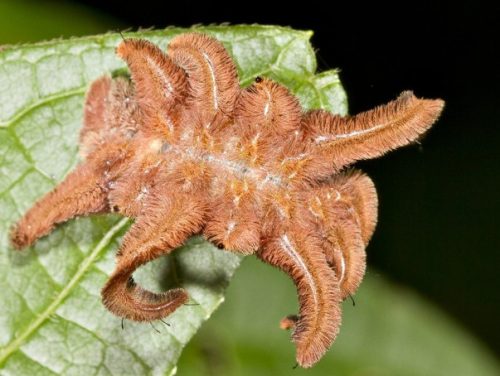
The Monkey Slug Caterpillar, scientifically named Phobetron pithecium, is a peculiar brown and fuzzy caterpillar in Arkansas. With a flattened furry body and nine pairs of unusual projections along the sides, it bears a distinctive appearance resembling a dead hairy spider or an old leaf. Caution is advised as it can sting, and its venom may cause pain if handled without protective gear. Found on apple, ash, birch, dogwood, hickory, oak, walnut, and willow trees, this tiny caterpillar is a unique sight in the region.
Southern Flannel Caterpillar
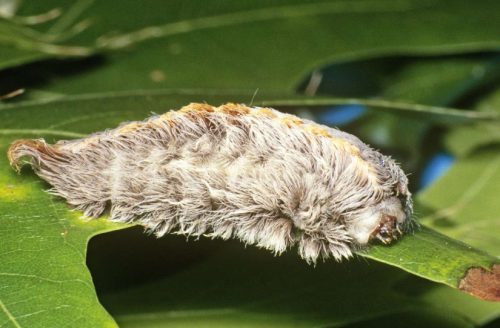
The Southern Flannel Caterpillar, also known as the puss caterpillar, is a furry caterpillar with hidden poisonous spikes that can cause severe stings. Common in the Southern States, particularly on oak and elm trees, it’s advised to avoid touching these grubs to prevent intense pain from their poisonous spines. Resembling a Persian cat, it’s also called asp larvae, alluding to the painful sting akin to a snake bite. Scientifically named Megalopyge opercularis, it has a brown, furry appearance with a broad rounded head, growing up to 2.5cm long.
Io Moth Caterpillar
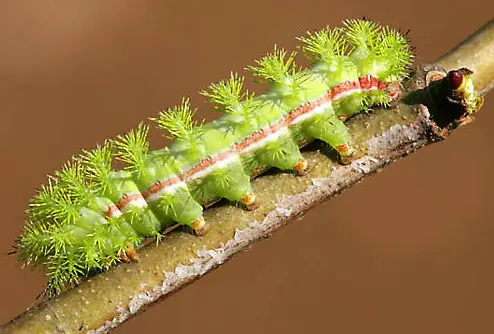
The Io Moth Caterpillar, scientifically known as Automeris io, is a green caterpillar with stinging hairs on its four sets of prolegs. Featuring pale-green hues and bands of bright green tufts of hair around its abdomen, its distinctive red and white stripes along the abdomen aid easy identification. Handling these caterpillars without protective gear can cause a burning sensation, nasty rashes, and pain. Found on hackberry, willow, redbud, pears, and blackberry plants, these crawling insects can reach a length of up to 6cm.
Saddleback Caterpillar
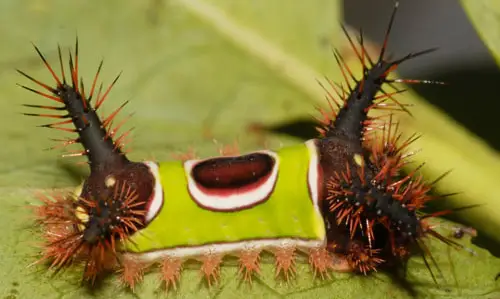
The Saddleback Caterpillar, scientifically named Acharia stimulea, is a slug-like caterpillar in Arkansas with venomous spikes on its back. Identified by a prominent saddle-like marking on the middle section, it stands out with a square green patch and a large brown circle. Growing up to 2.5cm, its menacing appearance is emphasized by stinging spines along the abdomen and horns at both ends. Found on apple, asters, blueberries, corn, citrus, dogwood, elms, and grapes, caution is advised when encountering this distinctive species.
Milkweed Tiger Caterpillar
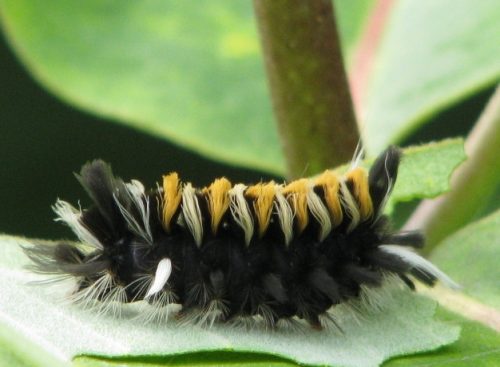
The Milkweed Tiger Caterpillar, scientifically named Euchaetes egle, is a small and hairy caterpillar adorned with colorful tufts of white, black, orange, and yellow hair. With a distinctive hairy brown body and orangey spiny tufts on the back, it features tan-colored tufts on its sides, giving it a unique appearance. Found feeding on milkweeds and dogbane plants, it’s advisable to refrain from touching them to avoid skin irritation caused by their hairs.
Giant Leopard Caterpillar
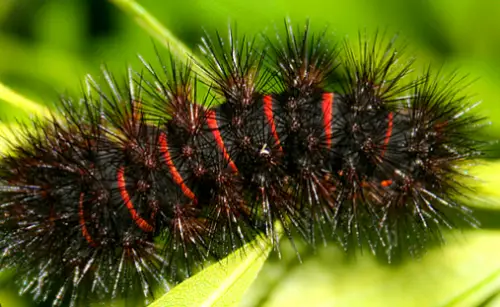
The Giant Leopard Caterpillar, scientifically known as Hypercompe scribonia, is a common black, spiky caterpillar in the southeastern United States. Notable for its conspicuous red bands between sharp spines, its fuzzy appearance and spiked body can cause pain if the spikes break into human skin. Growing up to 5cm long, this crawling insect feeds on banana, cherry, cabbage, maples, sunflowers, violets, and willows.
Banded Woolly Bear Caterpillar

The Banded Woolly Bear Caterpillar, scientifically named Pyrrharctia isabella, is a common black and brown furry caterpillar in Arkansas. Identified by the broad rusty brown band around its black body, it has an oblong appearance with fuzzy spines, making it challenging to locate the head and tail. Despite its appearance, these caterpillars are non-stinging and non-poisonous. When threatened, they roll into a ball shape. Found on plantain, aster, dandelion, goldenrod, and some grasses, these crawling creatures exhibit distinctive features with two black bands at both ends and a brown band around the middle section.
American Dagger Moth Caterpillar
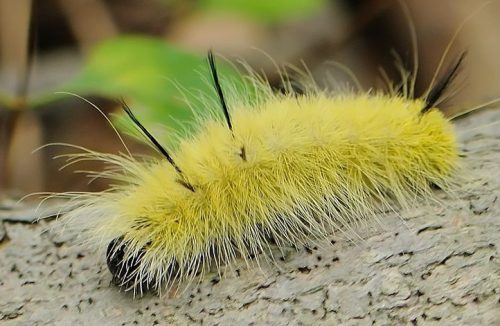
The American Dagger Moth Caterpillar, scientifically known as Acronicta Americana, is a pale yellow moth caterpillar with long black pencil hairs. Identified by its fuzzy yellow body and shiny black oval head, it features spiny hairs that cause skin irritation and rashes upon contact. Found on alder, ash, elm, maple, oak, willow, and other hardwood trees, these furry caterpillars exhibit distinctive yellow feathery spines with two pairs of long pencil hairs on their backs.
Tomato Hornworm Caterpillar
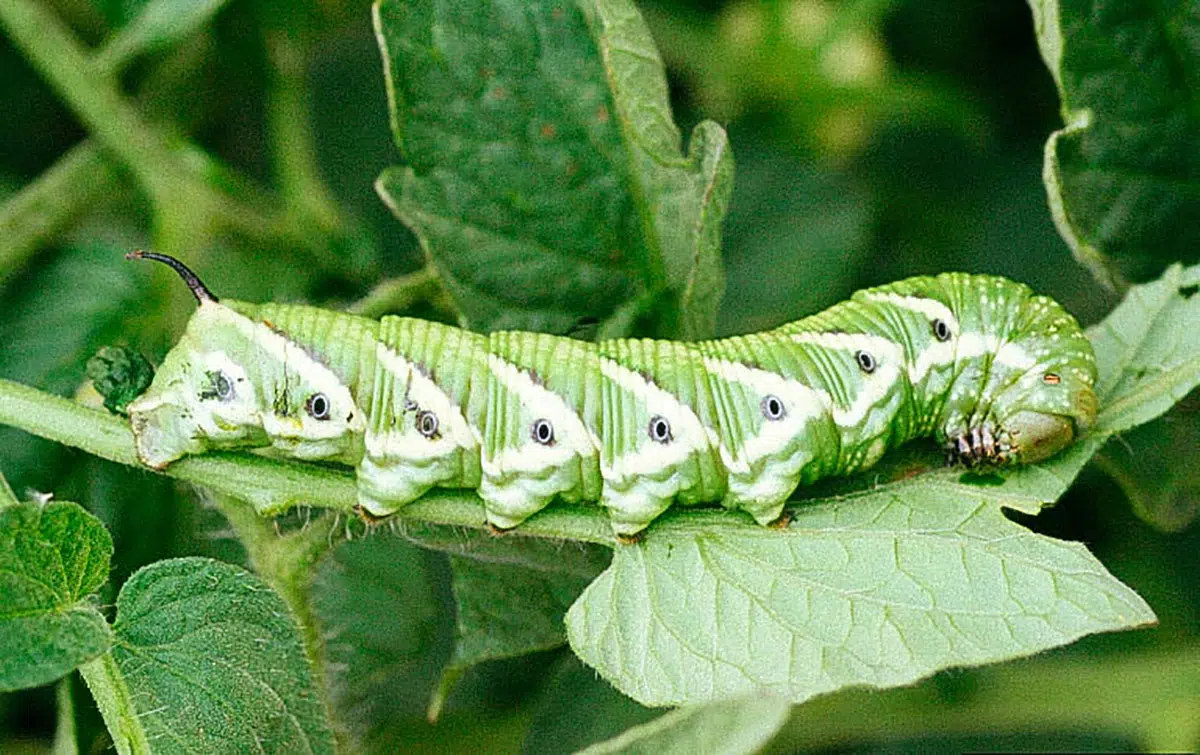
The Tomato Hornworm Caterpillar, scientifically named Manduca quinquemaculata, is a bright green garden pest with rows of eyespots and V-shaped markings. Recognizable by its pointed black tail projection, resembling a horn, it has a voracious appetite for tomato foliage. Growing up to 10cm long, it can be challenging to spot on tomato plants due to its effective leaf camouflage. To control infestations, chemical treatments are recommended.
White Admiral Caterpillar
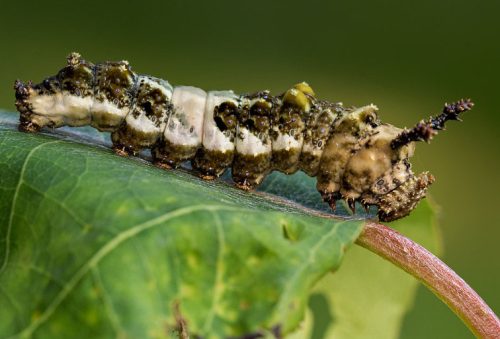
The White Admiral Caterpillar, scientifically known as Limenitis arthemis, is an Arkansas caterpillar that camouflages as bird droppings on branches to deter predators. Identified by its light green and brown body with uneven white blotches and two long black horns on the head, it feeds on willow, aspen, poplar, and birch leaves. After pupation, these caterpillars transform into vibrant iridescent blue and orange butterflies.
Common Pine Sawfly Caterpillar
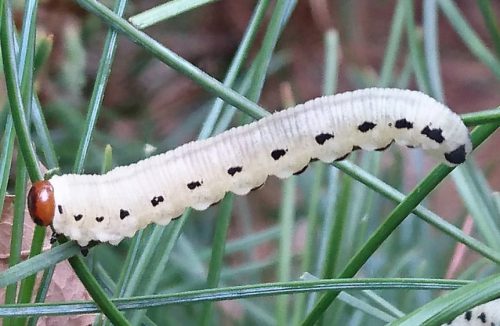
The Common Pine Sawfly Caterpillar, scientifically named Diprion pini, is a light green caterpillar with black spots on its sides and a single black line along the back. Found on Scottish pines, this caterpillar transforms into a pine sawfly, a type of wasp, after pupation. Notable features include a rusty red head that turns pale yellow and translucent in its final growth stages, adorned with fake eyespots before pupation.
Eight-Spotted Forester Caterpillar

The Eight-Spotted Forester Caterpillar, scientifically named Alypia octomaculata, is an orange caterpillar in Arkansas with black and white stripes around its body. Each segment features black tubercles resembling small round dots. Notable features include visible feathery spines, four sets of prolegs, and three sets of pointed forelegs. Found on grape and Virginia creeper plants, this caterpillar exhibits distinctive thick black-spotted orange stripes, tufts of thin spines, and conspicuous white and black stripes.
Queen Butterfly Caterpillar
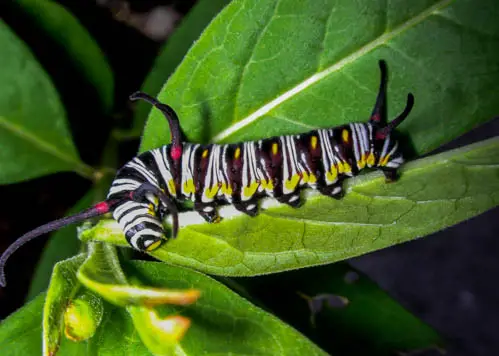
The Queen Butterfly Caterpillar, scientifically named Danaus gilippus, is adorned with black and white stripes and distinctive yellow dots on its back and sides. Notable features include six large fleshy tentacles on the head and tail. Growing up to 5cm long, it feeds on milkweed, frogfruit, and mistflower plants. Identified by its black and white stripes and yellow dots, this caterpillar transforms into a beautiful queen butterfly.
Black Swallowtail Caterpillar
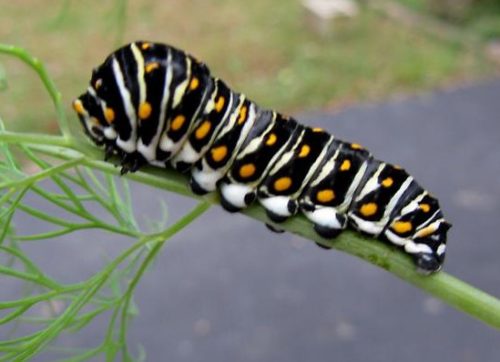
The Black Swallowtail Caterpillar, scientifically known as Papilio polyxenes, is a large green caterpillar in Arkansas featuring distinctive black and yellow stripes around each segment. Unlike some caterpillars, it lacks horns, spines, or spikes. Feeding on milkweeds, carrots, dill, parsley, and fennel, its smooth body and bright colors serve as a deterrent to potential predators, as they perceive it as dangerous.
Monarch Caterpillar
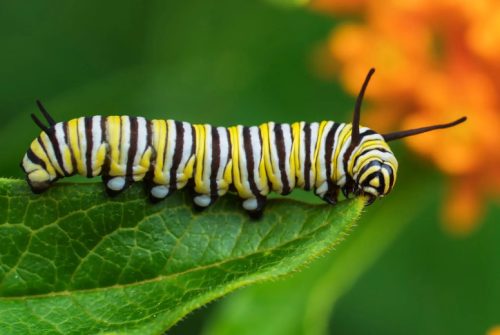
The Monarch Caterpillar, scientifically named Danaus plexippus, is a striped and horned caterpillar in Arkansas, adorned with bright yellow, white, and black colors around its body. Conspicuous colorful bands mark each segment, while long black horns on the head and shorter ones on the tail serve as distinctive features. Growing up to 5cm, they exhibit white dots on the prolegs and black forelegs. Feeding exclusively on milkweed plants, these caterpillars accumulate toxic substances in their bodies.
Azalea Caterpillars
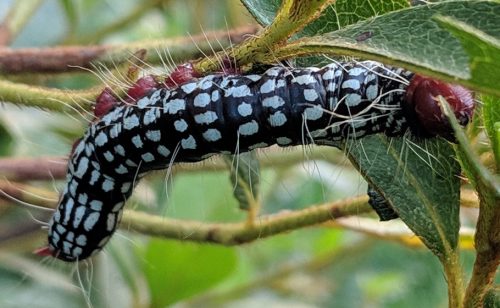
Azalea Caterpillars, scientifically named Datana major, are black Arkansas caterpillars with bright green bands around their plump, smooth bodies. Conspicuous features include a round orange head and tail section. Identified by their green, black, and orange markings, these voracious larvae pose a threat to the foliage of blueberry, apple, and oak trees.
Gulf Fritillary Caterpillar

The Gulf Fritillary Caterpillar, scientifically known as Dione vanillae, stands out with spiny spikes around its orange segments. Additional distinctive features include grayish-black stripes running lengthwise along its back, aiding in easy identification. Found on passion flowers, these caterpillars exhibit a smooth orange body adorned with striking blackish stripes and noticeable spines.
Spicebush Swallowtail Caterpillar
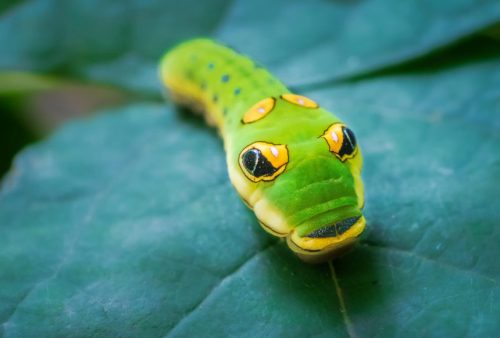
The Spicebush Swallowtail Caterpillar, scientifically known as Papilio Troilus, is an unusual green Arkansas caterpillar with large eye markings on its head. Transitioning from brown to green and finally yellowish in the last growth stage, it features distinctive blue circular patterns on each segment. Notably, black circles surrounded by yellow rings create eyespot markings on the head. Found on sweet bay and spicebush, this caterpillar exhibits unique identification features.
Redhumped Caterpillar
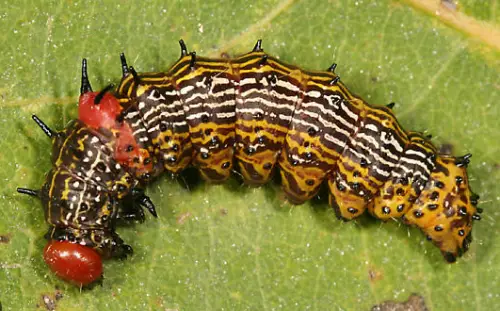
The Redhumped Caterpillar, scientifically named Schizura concinna, earns its name from the red hump on its back. Identified by yellow and white stripes, soft horn-like growths, cherry-red round heads, and feathery spines, it feeds on almond, apple, apricot, birch, and cherry trees. With a shiny black body covered in spiny spike bands, this Arkansas caterpillar displays distinctive features for easy recognition.
Red Admiral Caterpillar
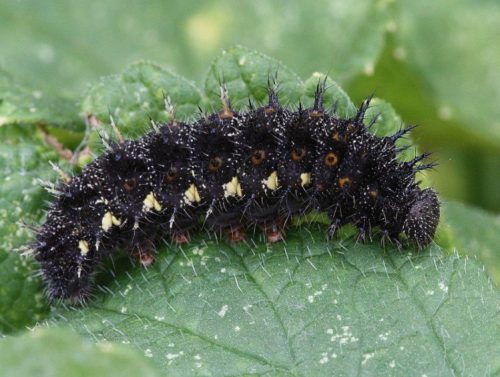
The Red Admiral Caterpillar, scientifically known as Vanessa atalanta, is a spiky black Arkansas caterpillar with fleshy spines and white dots around its body. Transforming into a grayish-brown color with dark red or brown dots along the sides, these caterpillars grow up to 2.5cm and feed on stinging nettle plants. After pupation, they metamorphose into striking black and red butterflies, showcasing their distinctive yellow bodies with black and white stripes.
Polyphemus Moth Caterpillar

The Polyphemus Moth Caterpillar, scientifically named Antheraea polyphemus, is a silk-spinning caterpillar with a light green body adorned with bright red dots around each segment. Notable features include plumpness and noticeable spines emerging from red tubercles. Changing color throughout growth stages, juvenile caterpillars are bright yellow, gradually transitioning to green. Found on apple, ash, birch, elm, hazel, maple, rose, and dogwood trees, this caterpillar’s identification features include a bright green translucent body with rows of red dots or silver spiny dots around its segments.
Evergreen Bagworm

The Evergreen Bagworm, belonging to the Psychidae family, is a shiny black or dark brown caterpillar in Arkansas. Its distinctive feature is the protective bag-like structures made from tree foliage, making it challenging to spot. These caterpillars infest and rapidly defoliate ornamental backyard trees such as black locust, elm, maple, poplar, oak, and willow, residing within their cocoon bags.
Yellow Forester Moth Caterpillar
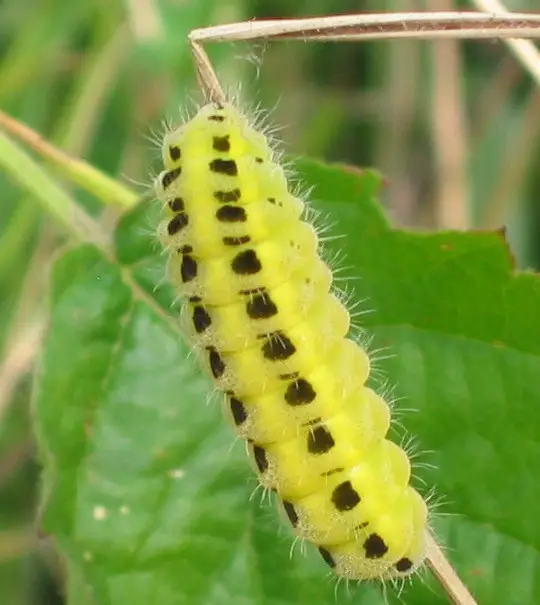
The Yellow Forester Moth Caterpillar, scientifically belonging to Zygaenidae, is a bright yellow or yellowish-green Arkansas caterpillar with rows of black dots on its back. Featuring spiny tufts on its back and sides, it feeds on herbaceous plants, specifically the Carolina laurelcherry. Growing up to 12.5cm long, these caterpillars exhibit distinctive bright yellow bodies with black markings along their sides and back.
Tiger Swallowtail Caterpillar

The Tiger Swallowtail Caterpillar, scientifically named Papilio glaucus, is a dark green caterpillar with a smooth body and distinctive eye-like markings on either side of its head. Toxic to birds and small predators, it possesses a defensive organ on its head that resembles a forked snake tongue, serving to scare potential threats. Found on black cherry, Carolina ash, sweet bay, and green ash trees, this caterpillar can be identified by its unusual eye-like markings and dark green abdomen.
Cecropia Moth Caterpillar
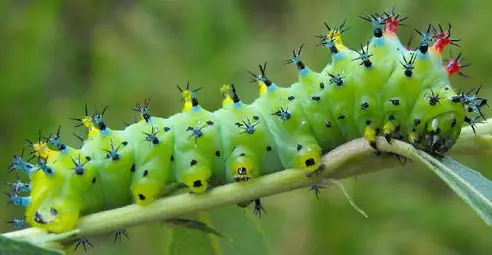
The Cecropia Moth Caterpillar, scientifically known as Hyalophora cecropia, is an Arkansas caterpillar with large, ridged segments featuring rows of blue and orange tubercles. Its lime-green body and black spikes create a stunning contrast. These striking green caterpillars transform into beautiful brown moths, often observed from April to June. Found on ash, birch, box elder, alder, elm, maple, and poplar trees, they can be identified by their visible segments adorned with rows of blue and yellow fleshy bumps, black spikes, and numerous orange tubercles.
Cabbage Looper Caterpillars
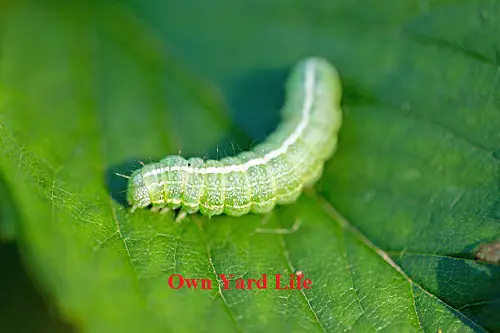
The Cabbage Looper Caterpillars, scientifically named Trichoplusia ni, are common in Arkansas during spring and summer. Recognized by their looping motion, these voracious creatures have a remarkable appetite, consuming three times their body weight up to three times a day. Growing up to 4cm long, they feed on tomato, soybean, pepper, and cabbage plants, exhibiting lime-green or yellow-green bodies. Their distinctive feature is the looping action when in motion.
Luna Moth Caterpillar
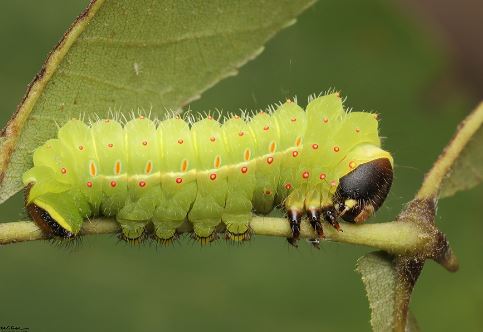
The Luna Moth Caterpillar, scientifically known as Actias luna, features a lime-green body adorned with red dots at the back and tufts of small spines. Recognized for raising the front part of its body while in motion, these caterpillars feed on birch, walnut, hickory, American sweet gum, and maple trees. Growing up to 9cm long due to their voracious appetite, they can be identified by their brown head, a bright red dots line running lengthwise, and three pairs of brown forelegs.
Forest Tent Caterpillars
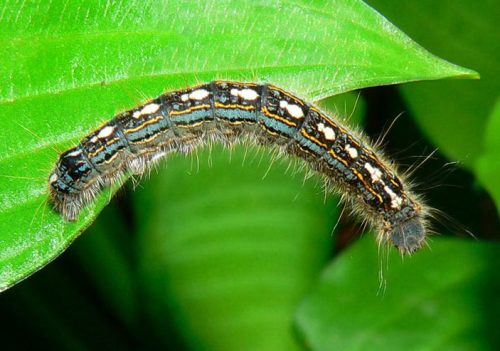
The Forest Tent Caterpillar, scientifically named Malacosoma disstria, is an Arkansas caterpillar with a dark body featuring yellow lines, lateral blue bands, and white patches. Notable for its feathery spines along the sides, this caterpillar is commonly observed in spring and summer. Feeding on willow, oak, birch, elm, and maple tree leaves, it can be identified by its blackish-brown appearance with blue, yellow, and black lines running lengthwise on its back.
Zebra Longwing Caterpillar
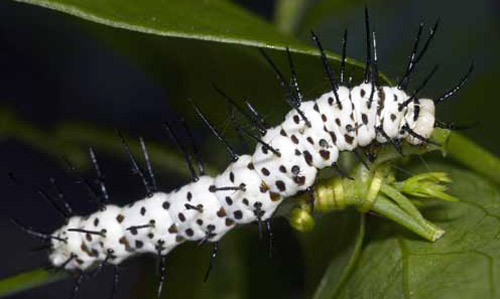
The Zebra Longwing Caterpillar, scientifically named Heliconius charithonia, is a pale-gray caterpillar with long black fleshy spikes, commonly found in Arkansas and other Southern United States. Covered in fine spines, the caterpillar feeds on passionflower vines, accumulating toxic substances in its body. The venom serves as a defense mechanism, causing a foul taste to predators.
Long-Tailed Skipper Caterpillar
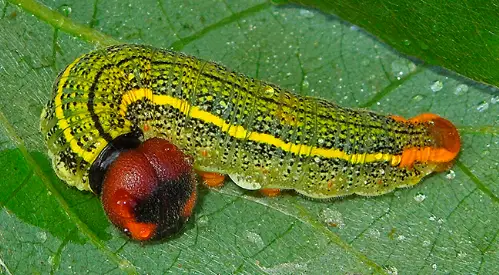
The Long-Tailed Skipper Caterpillar, scientifically named Urbanus proteus, is a large green, slug-like caterpillar with rings of yellow spots around the segments and a lateral greenish-yellow line along its back. Also known as the bean leafroller, it features a black globular head and orange patterns on its tail. Mature caterpillars turn pale green and develop pinkish patterns. Found on beans, peas, hog peanuts, and wisteria plants, identification features include a ball-like head, yellow markings, and orange prolegs.
Cloudless Sulphur Caterpillar

The Cloudless Sulphur Caterpillar, scientifically known as Phoebis sennae, is a light green caterpillar with black raised dots producing tiny spines. Soft yellowish spines cover the prolegs and abdomen, with an additional distinctive feature being the pale-yellow stripe along its sides. Found on Maryland wild-sensitive plants, these caterpillars can be identified by their green body adorned with bluish-black dots, light yellowish short spines, and a yellow lateral band along their sides.
People Who Read This Also Read:





